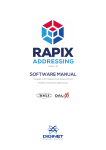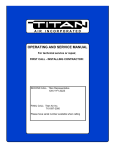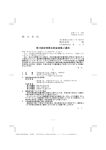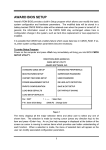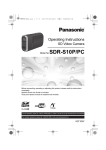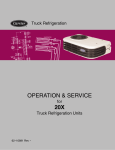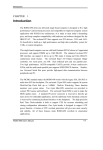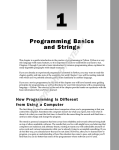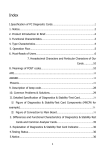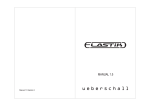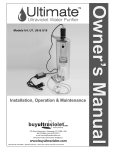Download USER`S MANUAL - Pdfstream.manualsonline.com
Transcript
USER'S MANUAL BPC-500-5820 Intel Pentium MMX/AMD K6-III BOX PC with CRT & Fast Ethernet Copyright© 2004 All Rights Reserved. Important Safety Instructions 1 Read these safety instructions carefully. 2 Keep this User's Manual for later reference. 3 Disconnect this equipment from any AC outlet before cleaning. Use a damp cloth. Do not use liquid or spray detergents for cleaning. 4. For plug-in equipment, the power outlet socket must be located near the equipment and must be easily accessible. 5 Keep this equipment away from humidity. 6 Put this equipment on a reliable surface during installation. Dropping it or letting it fall may cause damage. This equipment has been tested and found to comply with limits for a Class A digital device, pursuant to Part 15 of the FCC rules. These limits are designed to provide reasonable protection against harmful interference installations. This equipment generates, uses and can radiate radio frequency energy, and if not installed and used in accordance with the instructions, may cause harmful interference to radio communications. However, there is no guarantee that interference will not occur in a particular installation. 7 The openings on the enclosure are for air convection. Protect the equipment from overheating. DO NOT COVER THE OPENINGS. 8 Make sure the voltage of the power source is correct before connecting the equipment to the power outlet. If this equipment does cause interference to radio or television equipment reception, which can be determi ned by turning the equipment off and on, the user is encouraged to try to correct the interference by one or more of the following measures: -Reorient or relocate the receiving antenna 9 Position the power cord so that people cannot step on it. Do not place anything over the power cord. 10 All cautions and warnings on the equipment should be noted. -Move the equipment away from the receiver 11 If the equipment is not used for a long time, disconnect it from the power source to avoid damage by transient overvoltage. 12 Never pour any liquid into an opening. This may cause fire or electrical shock. 13 Never open the equipment. For safety reasons, the equipment should be opened only by qualified service personnel. 14 If one of the following situations arises, get the equipment checked by service personnel: a. The power cord or plug is damaged. The information in this document is subject to change without prior notice in order to improve the reliability, design and function. It does not represent a commitment on the part of the manufacturer. Under no circumstances will the manufacturer be liable for any direct, indirect, special, incidental, or consequen-tial damages arising from the use or inability to use the product or documentation, even if advised of the possibility of such damages. This document contains proprietary information protected by copyright. All rights are reserved. No part of this manual may be reproduced by any mechanical, electronic, or other means in any form without prior written permission of the manufacturer. FCC Class A -Plug the equipment into an outlet on a circuit different from that to which the receiver is connected -Consult the dealer or an experienced radio/television technician for additional suggestions You are cautioned that any change or modifications to the equipment not expressly approve by the party responsible for compliance could void Your authority to operate such equipment. BPC-500-5820 User's Manual 2 b. Liquid has penetrated into the equipment. c. The equipment has been exposed to moisture. d. The equipment does not work well, or you cannot get it to work according to the user's manual. e. The equipment has been dropped and damaged. f. The equipment has obvious signs of breakage. DO NOT LEAVE THIS EQUIPMENT IN AN UNCONTROLLED ENVIRON-MENT WHERE THE STORAGE TEMPERATURE IS BELOW -20° C (-4° F) OR ABOVE 60° C (140° F). THIS MAY DAMAGE THE EQUIPMENT. The sound pressure level at the operator's position according to IEC 704-1:1982 is no more than 70dB(A). About this User's Manual This User's Manual provides general information and installation instructions about the Box PC. This User's Manual is intended for experienced users and integrators with hardware knowledge of personal computers. If you are not sure about any description in this User's Manual, please consult your vendor before further handling. Ordering Information BPC-500-5820 Intel Pentium MMX/AMD K6-III BOX PC with CRT & Fast Ethernet Table of Contents Introduction ............................................................................. 4 Getting Started ........................................................................ 4 Dimension ...........................................................................................................5 Specification .......................................................................................................6 Overview ............................................................................................................6 Hardware Installation .............................................................. 7 Installing CPU .....................................................................................................8 Installing Memory Module ...................................................................................9 Installing Hard Disk Drive ..................................................................................10 Installing Wall-Mount Bracket ............................................................................11 Box PC Kernel Information .................................................... 12 System Resources ............................................................................................12 AWARD BIOS Setup............................................................... 14 Standard CMOS Setup .....................................................................................14 BIOS Features Setup ........................................................................................16 Chipset Features Setup ....................................................................................18 Power Management Setup ................................................................................20 PNP/PCI Configuration .....................................................................................22 Hardware Monitor .............................................................................................23 Integrated Peripherals (PIM-582 version) .........................................................23 Integrated Peripherals (PIM-582C version) .......................................................23 POST Codes .......................................................................... 25 Audible Error Messages ...................................................................................25 Visible Error Messages .....................................................................................25 POST Code Error Messages ............................................................................27 Howto : Flash the BIOS ......................................................... 30 Warranty ................................................................................ 30 BPC-500-5820 User's Manual 3 Introduction Box PC is targeted at many different application fields. By adopting Box PC, you can pinpoint specific markets, such as Thin Client, KIOSK, information booth, GSM Server, Getting Started This section will help you have your BPC-500-5820 up and running smoothly. For further information, please refer to PIM-582 User's Manual. environment-critical and space-critical applications. Box PC is specially designed for 3.5" and 5.25" Miniboards. The modular design of the Box PC is prepared for any OEM projects. Modular Box PC can be Packing List Before up and running, please make sure the package contains all of following accessories. easily modified to fit many different applications according to customers' requests. Compact-sized The kernel of BPC-500-5820 is PIM-582, which is a 5.25" drive size single board computer. The whole system consumes only a few space. CRT SVGA Part Number Manual PIM-582 Ver.1.2 Arbor Driver CD PAD-PW-060A-2YD CDROM IDE CABLE IDE Flat Cable Rubber Foot 1U CPU Cooler Zipper bag No.8 4011058200120 4311013300220 5490106021900 3432061000000 3432061000430 3820761202000 2610500502000 4111101241700 BPC-500-5820 can support super 2D video performance and consumes minimal power. Advanced storage solution Note : If any of the above items is damaged or missing, contact your vendor immediately. BPC-500-5820 comes with DiskOnChip®2000, a new generation of high performance single-chip Flash Disks. This unique data storage solution offers a better, faster and more cost-effective Flash Disk for applications with limited space and modest disk capacity requirements. Trustworthy The onboard Watchdog Timer can invoke an NMI or system RESET when your application loses control over the system. BPC-500-5820 User's Manual 4 Dimension SIM Card Unit : mm BPC-500-5820 User's Manual 5 Overview Rear Panel Power HDD LED LED Fast Ethernet Watchdog Timer Line In Mic Line Out USB1 USB2 LPT Audio Flash Disk Expansion Slot Serial Ports Parallel Ports USB Support OS 582) Realtek RTL8139 Generates system RESET or NMI, 1, 2, 10, 20, 110, 220 seconds timer interval ESS Solo-1 ES-19385, 3D sound on board 1 x DiskOnChip 2000 socket up to 288MB bytes PCI 32 bit, PC/104-16 bit 3 x RS232C, 1 x RS232C/485(COM2) SPP, EPP and ECP mode 2 x USB ports (12Mb/s, 1.5Mb/s) Windows 95/98/NT/, Linux External I/O S/W DC IN LAN VGA COM1 K/B Mouse Specification BPC-500-5820 Intel Pentium MMX/AMD K6-III BOX PC with CRT & Fast Ethernet System Memory System Chipset BIOS Display Support socket 7 AMD K6-III Up to 500MHz, VIA Cyrix MII, Intel Pentium MMX (Default 233MHz) Up to 1GB SDRAM in two 168-pin DIMM sockets (Default 32MB) SIS530 (Host, PCI, 3D AGP Video/Graphic) AWARD PCI/ISA PnP system BIOS C&T 69000 2MB DRAM on die HiQVideo Accelerator (PIM-582C) SiS-530 AGP, 2x AGP, 8MB shared memory (PIM- BPC-500-5820 User's Manual 1 x DB9 (RS232C) 1 x DB25 (SPP, EPP and ECP) 2 x USB ports (12Mb/s, 1.5Mb/s) 1 x RJ45 Port (10/100Mbps) 1 x DB15 Port 1 x PS2 mini DIN connector 1 x PS2 mini DIN connector Mic-in, Line-in, Line-out 1 x Power, 1 x HDD 1 x Power ON/OFF Power Adapter DC Power Output System Board CPU Serial Port Parallel Port USB LAN Display Keyboard Mouse Audio LEDs Switch AC Power Input V1:+5VDC +/- 5% @7A max. V2:+12VDC +/- 10% @3Amax. load, 60W 100-240V/50-60Hz, 1.5A max Mechanical & Environment Operating Temp. Storage Temp. Dimension (WxDxH) Weight Mounting 0 to 40 degree C -20 to 75 degree C 242 x 232 x 72mm (9.6" x 9.2" x 2.8") 2.2 kgs (4.84 lbs) Wallmount or Desktop 6 Hardware Installation Basic installation 1. CPU 2. Memory module 3. Hard Disk Drive 4. Wall-mount kit Removing Top Cover 1. On the both sides, locate the two screws that secure the top cover to the chassis. 1 3 2 4 2. Use screw drvier to remove the top cover screws. Keep the screws safely for later use. 3. Pull the top cover slightly upward the main unit until the side tabs are disengaged from chassis. 4. If you feel it's hard to pull up the top cover, just loose the screws that secure the main unit on each side a little bit. Then, you may pull up the top cover easily. BPC-500-5820 User's Manual 7 Installing CPU 3. Direct the PIN A1 Corner of CPU to that of socket on CPU borad. 1. Slide the CPU to the sideways of CPU cooler, lets the corners of CPU to match that of CPU cooler.. 3 1 4. Install the CPU module onto CPU board. 2. Screw on the screws on CPU cooler to secure CPU. 4 5. Connect the CPU coller power. 2 BPC-500-5820 User's Manual 5 8 Installing Memory Module 1. Locate the two DIMM SDRAM sockets on the main board of the main unit. 1 3 3. Align the DIMM on the socket and let the notches on the DIMM meets the break on socket. Firmly insert the DIMM into the socket until the retaining clips snap on and the DIMM is properly positioned. Then, lock the socket. 2. Unlock the socket by pressing the retaining clips outward. Note: Please note to install the memory module into DIMM1 if you have only one. 2 BPC-500-5820 User's Manual 9 Installing Hard Disk Drive 3. Secure the drive with side screws. 1. Reverse the top cover into inner-side. You may see two tabs which use to house Hard Disk Drive. 3 1 4. Connect IDE cable to the IDE connector on the drive. 2. Place Hard Disk Drive into suitable position, let the drive screw holes to meet the screw holes on securing tabs of top cover. 2 BPC-500-5820 User's Manual 4 10 Installing Wall-Mount Bracket 5. Connect the other end of IDE cable into the IDE connector of the board on main unit. 1. Locate the two screw holes on each side of Box PC, and match the screws on the wallmount kit. 5 6. Connect the power connector to the power connector of Hard Disk Drive. 1 2. Screws onto the main unit. 2 6 BPC-500-5820 User's Manual 11 Box PC Kernel Information 16-bit Digital I/O System Resources 2x Fan Power Interrupt Request (IRQ) 2 DIMM sockets SiS 530, SiS 5595 IRQ Address 0 Description System timer 1 Standard 101/102-Key or Microsoft Natural Keyboard 2 3 Programmable interrupt controller Communications Port (COM2) CPU up to AMD K6-3 at 550 MHz 4 6 Communications Port (COM1) Standard Floppy Disk Controller 7 Printer Port (LPT1) PCI Slot 8 10 System CMOS/real time clock IRQ Holder for PCI Steering 10 11 ESS Solo1 PCI AudioDrive (WDM) Realtek RTL8139/810x Family Fast Ethernet NIC 11 IRQ Holder for PCI Steering 12 13 PS/2 Compatible Mouse Port Numeric data processor 14 14 Primary IDE controller (dual fifo) SiS 5513 Dual PCI IDE Controller 15 Secondary IDE controller (dual fifo) 15 SiS 5513 Dual PCI IDE Controller C&T 69000 PC/104 Connector DiskOnChip socket RTL 8139A 10/100 Mbps P8 Power Connector 2x EIDE 1x FDD 1x Printer Port 2x USB PS/2 Keyboard SIR COM1/2/3/4 RS-485 Mouse GAME Audio Port ESS Solo-1 Direct Memory Access (DMA) DMA 2 Description Standard Floppy Disk Controller 4 Direct memory access controller Note: For further information, please refer to PIM-582 User's Manual. BPC-500-5820 User's Manual 12 Ports Input/Output (IO) I/O Address 0020-0021 Description Programmable interrupt controller 0040-0043 0060-0060 System timer Standard 101/102-Key or Microsoft Natural Keyboard 0061-0061 0064-0064 System speaker Standard 101/102-Key or Microsoft Natural Keyboard 0070-0071 System CMOS/real time clock 0081-0083 0087-0087 Direct memory access controller Direct memory access controller 0089-008B Direct memory access controller 008F-0091 Direct memory access controller 00A0-00A1 Programmable interrupt controller 00C0-00DF Direct memory access controller 00F0-00FF Numeric data processor 0170-0177 0170-0177 SiS 5513 Dual PCI IDE Controller Secondary IDE controller (dual fifo) 01F0-01F7 Primary IDE controller (dual fifo) 01F0-01F7 0201-0201 SiS 5513 Dual PCI IDE Controller Gameport Joystick 0290-029F 02F8-02FF PCI bus Communications Port (COM2) 0376-0376 SiS 5513 Dual PCI IDE Controller 0376-0376 0378-037F Secondary IDE controller (dual fifo) Printer Port (LPT1) 03F8-03FF Communications Port (COM1) 0480-048F PCI bus 04D0-04D1 PCI bus 0CF8-0CFF PCI bus 4000-400F 4000-4007 SiS 5513 Dual PCI IDE Controller Primary IDE controller (dual fifo) 4008-400F Secondary IDE controller (dual fifo) 5000-503F Motherboard resources D000-D0FF Realtek RTL8139/810x Family Fast Ethernet NIC D400-D43F ESS Solo1 PCI AudioDrive (WDM) D800-D80F ESS Solo1 PCI AudioDrive (WDM) DC00-DC0F ESS Solo1 PCI AudioDrive (WDM) E000-E003 E400-E403 ESS Solo1 PCI AudioDrive (WDM) ESS Solo1 PCI AudioDrive (WDM) 0000-000F Direct memory access controller 03B0-03BB Chips and Tech. 69000 PCI 03C0-03DF Chips and Tech. 69000 PCI 03F2-03F5 Standard Floppy Disk Controller 03F6-03F6 03F6-03F6 Primary IDE controller (dual fifo) SiS 5513 Dual PCI IDE Controller BPC-500-5820 User's Manual 13 AWARD BIOS Setup Standard CMOS Setup The PIM-582 uses the Award PCI/ISA BIOS for the system configuration. The Award BIOS setup program is designed to provide the maximum flexibility in configuring the system by offering various options which could be selected for end-user requirements. This chapter is written to assist you in the proper usage of these features. To access AWARD PCI/ISA BIOS Setup program, press <Del> key. The Main Menu will be displayed at this time. ROM PCI/ISA BIOS (2A5IMTPD) CMOS SETUP UTILITY AWARD SOFTWARE, INC. STANDARD CMOS SETUP HARDWARE MONITOR BIOS FEATURES SETUP INTEGRATED PERIPHERALS CHIPSET FEATURES SETUP SUPERVISOR PASSWORD POWER MANAGEMENT SETUP USER PASSWORD PNP/PCI CONFIGURATION IDE HDD AUTO DETECTION LOAD BIOS DEFAULTS SAVE & EXIT SETUP LOAD SETUP DEFAULTS EXIT WITOUT SAVE ↑↓→← Esc: Quit F10: Save & Exit Setup : Select Item (Shift)F2 : Change Color Time, Date, Hard Disk Type ROM PCI/ISA BIOS (2A5IMTPD) STANDARD CMOS SETUP AWARD SOFTWARE, INC. Date (mm:dd:yy) : Mon,21, Jun 1999 Time (hh:mm:ss) :20:37:12 HARD DISKS MODE TYPE SIZE CYLS HEAD Drive A : 1.44M , 3.5 in. Drive B : None Floppy Mode 3 Support :Disabled Video : EGA / VGA Esc: Quit ↑↓→← PRECOM LANDE SECTOR Base Memory : 640K Extended Memory : 31744K Other Memory : 384K : Select Item PU/PD/+/- : Date The BIOS determines the day of the week from the other date information; this field is for information only. Time The time format is based on the 24-hour military-time clock. For example, 1 p.m. is 13:00:00. Press the ?or ( key to move to the desired field . Press the PgUp or PgDn key to increment the setting, or type the desired value into the field. Hard Disks The BIOS supports up to four IDE drives. This section does not show information about other IDE devices, such as a CD-ROM drive, or about other hard drive types, such as SCSI drives. NOTE : recommend that you select type AUTO for all drives. The BIOS can automatically detect the specifications and optimal operating mode of almost all IDE hard drives. When you select type AUTO for a hard drive, the BIOS detects its specifications during POST, every time the system boots. If you do not want to select drive type AUTO, other methods of selecting the drive type are available: 1. Match the specifications of your installed IDE hard drive(s) with the preprogrammed values for drive types 1 through 45. BPC-500-5820 User's Manual 14 2. Select USER and enter values into each drive parameter field. 360K : 1.2M : 720K : 1.44M : 2.88M : 3. Use the IDE HDD AUTO DECTECTION function in Setup. Here is a brief explanation of drive specifications: 5.25 in5-1/4 inch PC-type standard drive 5.25 in5-1/4 inch AT-type high-density drive 3.5 in3-1/2 inch double-sided drive 3.5 in3-1/2 inch double-sided drive 3.5 in3-1/2 inch double-sided drive Type: The BIOS contains a table of pre-defined drive types. Each defined drive type has a specified number of cylinders, number of heads, write precompensation factor, landing zone, and number of sectors. Drives whose specifications do not accommodate any pre-defined type are classified as type USER. Size: Disk drive capacity (approximate). Note that this size is usually slightly greater than the size of a formatted disk given by a disk-checking program. Cyls: Number of cylinders Head: Number of heads Halt On During the power-on self-test (POST), the computer stops if the BIOS detects a hardware error. You can tell the BIOS to ignore certain errors during POST and continue the boot-up process. These are the selections: Precomp: Write precompensation cylinder No errors POST does not stop for any errors. Landz: Landing zone All errors Sector: Number of sectors If the BIOS detects any non-fatal error, POST stops and prompts you to take corrective action. Mode: Auto, Normal, large, or LBA All, But Keyboard POST does not stop for a keyboard error, but stops for all other errors. Auto The BIOS automatically determines the optimal mode. All, But Diskette POST does not stop for diskette drive errors, but stops for all other errors. Normal Maximum number of cylinders, heads, and sectors supported are 1024, 16, and 63. All, But Disk/Key POST does not stop for a keyboard or disk error, but stops for all other errors. Floppy Mode 3 Support Enables support for 1.2 MB format capacity on 3? disk drives. This format is commonly used Japan. Video Select the type of primary video subsystem in your computer. The BIOS usually detects the correct video type automatically. The BIOS supports a secondary video subsystem, but you do not select it in Setup. Large For drives that do not support LBA and have more than 1024 cylinders. Applicable to only a few drives. LBA Logical Block Addressing. During drive accesses, the IDE controller transforms the data address described by sector, head, and cylinder number into a physical block address, significantly improving data transfer rates. For drives with greater than 1024 cylinders. Drive A, B Select the correct specifications for the diskette drive(s) installed in the computer. None : No diskette drive installed BPC-500-5820 User's Manual 15 BIOS Features Setup quick POST. Better to find a problem during POST than lose data during your work. ROM PCI/ISA BIOS (2A5IMTPD) STANDARD CMOS SETUP AWARD SOFTWARE, INC. Virus Warning CPU Internal Cache External Cache Quick Power On Self Test Boot Sequence Swap Floppy Drive Boot Up Floppy Seek Boot Up NumLock Status Memory Parity Check Typematic Rate Setting Typematic Rate (Char/Sec) Typematic Delay (Msec) Security Option PCI/VGA Palette Snoop OS Select for DRAM > 64MB Report No FDD For Win95 : Disabled : Enabled : Enabled : Disabled : A,C,SCSI : Disabled : Enabled : On : Disabled : Disabled :6 : 250 : Setup : Disabled : Non-OS2 : Yes Video BIOS Shadow C8000-CBFFF Shadow CC000-CFFFF Shadow D0000-D3FFF Shadow D4000-D7FFF Shadow D8000-DBFFF Shadow DC000-DFFFF Shadow Cyrix 6x86/MII CPUID : Enabled : Disabled : Disabled : Disabled : Disabled : Disabled : Disabled : Enabled Esc: Quit ↑↓→← : Select Item F1 : Help PU/PD/+/- : Modify F5 : Old Values (Shift)F2: Color F6 : Load BIOS Defaults F7 : Load Setup Defaults Virus Warning When enabled, you receive a warning message if a program (specifically, a virus) attempts to write to the boot sector or the partition table of the hard disk drive. You should then run an anti-virus program. Keep in mind that this feature protects only the boot sector, not the entire hard drive. CPU Internal Cache & CPU External Cache Cache memory is additional memory that is much faster than conventional DRAM (system memory). CPUs from 486-type on up contain internal cache memory, and most, but not all, modern PCs have additional (external) cache memory. When the CPU requests data, the system transfers the requested data from the main DRAM into cache memory, for even faster access by the CPU. Quick Power On Self Test Select Enabled to reduce the amount of time required to run the power-on self-test (POST). A quick POST skips certain steps. We recommend that you normally disable BPC-500-5820 User's Manual Boot Sequence The original IBM PCs loaded the DOS operating system from drive A (floppy disk), so IBM PC-compatible systems are designed to search for an operating system first on drive A, and then on drive C (hard disk). However, modern computers usually load the operating system from the hard drive, and may even load it from a CD-ROM drive. Swap Floppy Drive This field is effective only in systems with two floppy drives. Selecting Enabled assigns physical drive B to logical drive A, and physical drive A to logical drive B. Boot Up Floppy Seek When Enabled, the BIOS tests (seeks) floppy drives to determine whether they have 40 or 80 tracks. Only 360-KB floppy drives have 40 tracks; drives with 720 KB, 1.2 MB, and 1.44 MB capacity all have 80 tracks. Because very few modern PCs have 40-track floppy drives, we recommend that you set this field to Disabled to save time. Boot Up NumLock Status Toggle between On or Off to control the state of the NumLock key when the system boots. When toggled On, the numeric keypad generates numbers instead of controlling cursor operations. Memory Parity Check Parity is a measure of the consistency of your system's RAM, memory chips. Plus, there is both parity and non-parity memory. At boot, the Award BIOS both sizes and tests all memory. Normally, when a parity error is detected, the BIOS will display a message describing the problem as well as the problem's location, if possible. The boot process will then terminate and you will not be able to continue until the bad chip or SIMM is located and replaced. Disabling the Memory Parity Check allows the system to by-pass the test and allow your system to boot. You then have a choice of continuing to operate your system or attempting the remedying the problem. Typematic Rate Setting When Disabled, the following two items (Typematic Rate and Typematic Delay) are irrelevant. Keystrokes repeat at a rate determined by the keyboard controller in your system. When Enabled, you can select a typematic rate and typematic delay. Typematic Rate (Chars/Sec) When the typematic rate setting is enabled, you can select a typematic rate (the rate at which character repeats when you hold down a key) of 6, 8, 10,12, 15, 20, 24 or 30 16 characters per second. Typematic Delay (Msec) When the typematic rate setting is enabled, you can select a typematic delay (the delay before key strokes begin to repeat) of 250, 500, 750 or 1000 milliseconds. Security Option If you have set a password, select whether the password is required every time the System boots, or only when you enter Setup. System The system will not boot and access to Setup will be denied if the correct password is not entered at the prompt. Setup The system will boot, but access to Setup will be denied if the correct password is not entered at the prompt. C8000-CBFFF Shadow Enabling any of the C8000~DFFFF segments allows components to move their firmware into these upper memory segments. However your computer can lock-up doing so, because some devices don't like being shadowed at those particular 16 KB segments of upper memory. Note - In Windows 95, double click 'Computer' within Device Manager and select 'Memory'. This will tell you what segments (if any) are being shadowed For DOS you can use MSD.EXE to see what segments are claimed. CC000-CFFFF - D0000-D3FFF - D4000-D7FFF - D8000-DBFFF and DC000-DFFFF - Same as above. Cyrix 6x86/MII CPUID When using a Cyrix CPU this option should be enabled to correctly determine the Cyrix CPU type. Note: To disable security, select PASSWORD SETTING at Main Menu and then you will be asked to enter password. Do not type anything and just press Enter, it will disable security. Once the security is disabled, the system will boot and you can enter Setup freely. PCI/VGA Palette Snoop Normally this option is always disabled ! Nonstandard VGA display adapters such as overlay cards or MPEG video cards may not show colors properly. Setting "PCI/VGA Palette Snoop" to Enable should correct this problem. If the PCI/VGA Palette Snoop is "Enabled", any I/O access on the ISA-bus to the VGA card's palette registers will be reflected on the PCI bus. This will allow overlay cards to adapt to the changing palette colors. OS Select for DRAM > 64MB Non-OS/2 If your operating system is not OS/2 OS/2 If system DRAM is more than 64MB and if your operating system is OS/2. Report No FDD For WIN 95 Select Yes to release IRQ6 when the system contains no floppy drive, for compatibility with Windows 95 logo certification. In the "Integrated Peripherals" menu screen, select Disabled for the Onboard FDC Controller field. Video BIOS Shadow Enabled this copies the video BIOS from ROM to RAM. effectively enhancing performance, and reducing the amount of upper memory available by 32KB (the C0000~C7FFF area of memory between 640 KB and 1 MB is used). BPC-500-5820 User's Manual 17 Chipset Features Setup Ref / Act Command Delay Set the DRAM clock of the refresh command to refresh/active command delay. Refresh Queue Depth Set the depth of refresh queue. ROM PCI/ISA BIOS (2A5IMTPD) CHIPSET FEATURES SETUP AWARD SOFTWARE, INC. Refresh Rate Control Ref/Act Command delay Refresh Queue Depth RAS Precharge Time RAS to CAS Delay ISA Bus Clock Frequency Starting Point of Paging NA# Enable L2 Cache Burst RD Cycle Asyn/Sync Mode CPU DRAM SDRAM CAS Latency SDRAM WR Retite Rate DRAM Opt RAS Precharge PCI Peer Concurrency Read Prefetch Memory RD Assert TRDY After Prefet CPU to PCI Burst Mem. WR CPU to PCI Post Write AGP Aperture Size System BIOS Cacheable : 15.6us : 6T : 12 : 3T : 3T : PCICLK/4 : 1T : Disabled : Delay 1T : Asynchron : 3T : X-2-2-2 : Disabled : Disabled : Enabled : 2 QWs : Disabled : Disabled : 64MB : Enabled Video BIOS Cachable Memory Hole at 15/16M PCI Post Write Buffer PCI Delayed Transaction : Enabled : Enabled : Disabled : Disabled RAS to CAS Delay TWhen DRAM is refreshed, both rows and columns are addressed separately. This setup item allows you to determine the timing of the transition from RAS (row address strobe) to CAS (column address strobe). The choice: 2T, 3T, 4T, 5T. Esc: Quit ↑↓→← : Select Item F1 : Help PU/PD/+/- : Modify F5 : Old Values (Shift)F2: Color F6 : Load BIOS Defaults F7 : Load Setup Defaults This Chipset Feature Setup screen allows you to configure the system based on the specific features of the installed chipset. This chipset manages bus speeds and access to system memory resources, such as DRAM and the external cache. It also coordinates communications between the conventional ISA bus and the PCI bus. It must be stated that these items should never need to be altered. The default settings have been chosen because they provide the best operating conditions for your system. The only time you might consider making any changes would be if you discovered that data was being lost while using your system. The first chipset settings deal with CPU access to dynamic random access memory (DRAM). The default timings have been carefully chosen and should only be altered if data is being lost. Such a scenario might well occur if your system had mixed speed DRAM chips installed so that greater delays may be required to preserve the integrity of the data held in the slower memory chips. Refresh Rate Control Select the period required to refresh the DRAMs, according to DRAM specifications. BPC-500-5820 User's Manual RAS Precharge Time The precharge time is the number of cycles it takes for the RAS to accumulate its charge before DRAM refreshes. If insufficient time is allowed, refresh may be incomplete and the DRAM may fail to retain data. The Choice: 2T, 3T, 4T, 5T. ISA Bus Clock Frequency You can set the speed of the AT bus at one-third or one-fourth of the CPU clock speed. The choice: 7.159MHz, PCICLK/3, PCICLK/4. Starting Point of Paging This value controls the start timing of memory paging operations. The choice: 1T, 2T, 4T, 8T. NA# Enable Selecting Enabled permits pipelining, in which the chipset signals the CPU for a new memory address before all data transfers for the current cycle are complete, resulting in faster performance. The choice: Enabled, Disabled. L2 Cache Burst RD Cycle These timing numbers are the pattern of cycles the CPU uses to read data from the cache. The choice: Normal, Delay 1T. Asyn/Sync Mode CPU/DRAM This feature can only be enabled when the frequency of CPU clock and the frequency of DRAM clock are the same and the skew between these two clocks should be zero. The choice: Asynchronous, Synchronous. SDRAM CAS Latency When synchronous DRAM is installed, the number of clock cycles of CAS latency depends on the DRAM timing. Do not reset this field from the default value specified by the system designer. The choice: 2T, 3T. 18 SDRAM WR Retire Rate The system designer must select the correct timing for data transfers from the write buffer to memory, according to DRAM specifications The choice: 0WS, 1WS. Asyn/Sync Mode CPU/DRAM This feature can only be enabled when the frequency of CPU clock and the frequency of DRAM clock are the same and the skew between these two clocks should be zero. The choice: Asynchronous, Synchronous. DRAM Opt RAS Precharge The precharge time is the number of cycles it takes for the RAS to accumulate its charge before DRAM refreshes. If insufficient time is allowed, refresh may be incomplete and the DRAM may fail to retain data. The choice: Enabled, Disabled. SDRAM CAS Latency When synchronous DRAM is installed, the number of clock cycles of CAS latency depends on the DRAM timing. Do not reset this field from the default value specified by the system designer. The choice: 2T, 3T. PCI Peer Concurrency Peer concurrency means that more than one PCI device can be active at a time. The choice: Enabled, Disabled. SDRAM WR Retire Rate The system designer must select the correct timing for data transfers from the write buffer to memory, according to DRAM specifications The choice: 0WS, 1WS. RAS Precharge Time The precharge time is the number of cycles it takes for the RAS to accumulate its charge before DRAM refreshes. If insufficient time is allowed, refresh may be incomplete and the DRAM may fail to retain data. The Choice: 2T, 3T, 4T, 5T. RAS to CAS Delay TWhen DRAM is refreshed, both rows and columns are addressed separately. This setup item allows you to determine the timing of the transition from RAS (row address strobe) to CAS (column address strobe). The choice: 2T, 3T, 4T, 5T. DRAM Opt RAS Precharge The precharge time is the number of cycles it takes for the RAS to accumulate its charge before DRAM refreshes. If insufficient time is allowed, refresh may be incomplete and the DRAM may fail to retain data. The choice: Enabled, Disabled. PCI Peer Concurrency Peer concurrency means that more than one PCI device can be active at a time. The choice: Enabled, Disabled. ISA Bus Clock Frequency You can set the speed of the AT bus at one-third or one-fourth of the CPU clock speed. The choice: 7.159MHz, PCICLK/3, PCICLK/4. Starting Point of Paging This value controls the start timing of memory paging operations. The choice: 1T, 2T, 4T, 8T. NA# Enable Selecting Enabled permits pipelining, in which the chipset signals the CPU for a new memory address before all data transfers for the current cycle are complete, resulting in faster performance. The choice: Enabled, Disabled. L2 Cache Burst RD Cycle These timing numbers are the pattern of cycles the CPU uses to read data from the cache. The choice: Normal, Delay 1T. BPC-500-5820 User's Manual 19 Power Management Setup User Defined ROM PCI/ISA BIOS (2A5IMTPD) POWER MANAGEMENT SETUP AWARD SOFTWARE, INC. ACPI Function Power Management Video Off Option Video Off Method Switch Function Doze Speed (div by) Stdby Speed (div by) Modem Use IRQ Hot Key Function As ** PM Timers ** HDD Off After Doze Mode Standby Mode Suspend Mode ** PM Events ** HDD Ports Activity COM Ports Activity LPT Ports Activity : Enabled : User Define : Always On : V/H SYNC+Blank : Break/Wake : 2/8 : 1/8 :3 : Poer Off VGA Activity IRQ [3-7,9-15], NMI IRQ 8 Break Suspend : Enabled : Enabled : Disabled Suspend --> Off Monitor blanked when the systems enters the Suspend mode. Susp,Stby --> Off Monitor blanked when the system enters either Suspend or Standby modes. V/H SYNC+Blank causes the system to turn off the vertical and horizontal synchronization ports and write blanks to the video buffer. Blank Screen This option only writes blanks to the video buffer. Esc: Quit ↑↓→← : Select Item F1 : Help PU/PD/+/- : Modify F5 : Old Values (Shift)F2: Color F6 : Load BIOS Defaults F7 : Load Setup Defaults ACPI Function Select Enabled only if your computer soperating system supports the Advanc ed Configuration and Power Interface (ACPI) specification. Currently, Windows 98 and Windows NT 5.0 (beta) support ACPI. Power Management There are 4 selections for Power Management, 3 of which have fixed mode : Disable (default) No power management. Disables all four modes Min. Power Saving Minimum power management. Doze Mode = 1 hr. Standby Mode = 1 hr., Suspend Mode = 1 hr., and HDD Power Down = 15 min. Max. Power Saving Maximum power management -- ONLY AVAILABLE FOR SL CPU'S. Doze Mode = 1 min., Standby Mode = 1 min., Suspend Mode = 1 min., and HDD Power Down = 1 min. BPC-500-5820 User's Manual Video Off Option When enabled, this feature allows the VGA adapter to operate in a power saving mode.This determines the manner in which the monitor is blanked. Always On Monitor will remain on during power saving modes. All Modes --> Off Monitor blanked when the system enters any power saving mode. Video Off Method This determines the manner in which the monitor is blanked. : 15 Min : 4 Hours : 4 Hours : 4 Hours : Enabled : Enabled : Enabled Allows you to set each mode individually. When not disabled, each of the ranges are from 1 min. to 1 hr. except for HDD Power Down which ranges from 1 min. to 15 min. and disable. DPMS Initial display power management signaling. Switch Function You can choose whether or not to permit your system to enter complete Suspend mode. Suspend mode offers greater power savings, with a correspondingly longer awakening period. The choice: Deturbo, Break, Break/Wake, Disabled. Doze Speed (div by) Sets the CPU's speed during Doze mode. The speed is reduced to a fraction of the CPU's normal speed. The divisors range from 1 to 8 The choice: 1~8. Stdby Speed (div by) Select a divisor to reduce the CPU speed during Standby mode to a fraction of the full CPU speed. The speed is reduced to a fraction of the CPU's normal speed. The divisors range from 1 to 8-0. The choice: 1~8 Modem Use IRQ Name the interrupt request (IRQ) line assigned to the modem (if any) on your system. Activity of the selected IRQ always awakens the system. Hot Key Function As Select Enabled if your system has a hot key for soft power off. The choice: Enabled, Disabled. 20 PM Timers The following four modes are Green PC power saving functions which are only user configurable when User Defined Power Management has been selected. See above for available selections. HDD Off After By default, this item is Disabled, meaning that no matter the mode the rest of the system, the hard drive will remain ready. Otherwise, you have a range of choices from 1 to 15 minutes or Suspend. This means that you can elect to have your hard disk drive be turned off after a selected number of minutes or when the rest of the system goes into a Suspend mode. Doze Mode When enabled and after the set time of system inactivity, the CPU clock will run at slower speed while all other devices still operate at full speed. When set to On (default), any event occurring at VGA will awaken a system which has been powered down. IRQ [ 3-7, 9-15], NMI The following is a list of IRQ's, Interrupt ReQuests, which can be exempted much as the COM ports and LPT ports above can. When an I/O device wants to gain the attention of the operating system, it signals this by causing an IRQ to occur. When the operating system is ready to respond to the request, it interrupts itself and performs the service. As above, the choices are On and Off. When set On, activity will neither prevent the system from going into a power management mode nor awaken it. IRQ 8 Break Suspend You can Enable or Disable monitoring of IRQ8 (the Real Time Clock) so it does not awaken the system from Suspend mode. Standby Mode When enabled and after the set time of system inactivity, the fixed disk drive and the video would be shut off while all other devices still operate at full speed. Suspend Mode When enabled and after the set time of system inactivity, all devices except the CPU will be shut off. PM Events You may disable activity monitoring of some common I/O events and interrupt requests so they do not wake up the system. The default wake-up event is keyboard activity. When On (or named, in the case of LPT & COM), any activity from one of the listed system peripheral devices or IRQs wakes up the system. HDD Ports Activity When set to On (default), any event occurring at a HDD (serial) port will awaken a system which has been powered down. COM Port Activity When set to On (default), any event occurring at a hard or floppy drive port will awaken a system which has been powered down. LPT Port Activity When set to On (default), any event occurring at a LPT (printer) port will awaken a system which has been powered down. VGA Activity BPC-500-5820 User's Manual 21 PNP/PCI Configuration IRQ n Assigned to When resources are controlled manually, assign each system interrupt as one of the following types, depending on the type of device using the interrupt: ROM PCI/ISA BIOS (2A5IMTPD) PNP/PCI CONFIGURATION AWARD SOFTWARE, INC. Resources Controlled By : Manual Reset Configuration Data : Disabled IRQ-3 assigned to : PCI/ISA Pnp IRQ-4 assigned to : PCI/ISA Pnp IRQ-5 assigned to : PCI/ISA Pnp IRQ-7 assigned to : PCI/ISA Pnp IRQ-9 assigned to : PCI/ISA Pnp IRQ-10 assigned to : PCI/ISA Pnp IRQ-11 assigned to : PCI/ISA Pnp IRQ-12 assigned to : PCI/ISA Pnp IRQ-14 assigned to : PCI/ISA Pnp IRQ-15 assigned to : PCI/ISA Pnp DMA-0 assigned to : PCI/ISA Pnp DMA-1 assigned to : PCI/ISA Pnp DMA-3 assigned to : PCI/ISA Pnp DMA-5 assigned to : PCI/ISA Pnp DMA-6 assigned to : PCI/ISA Pnp DMA-7 assigned to : PCI/ISA Pnp PCI IRQ Activated By Legacy ISA : Level PCI/ISA PnP Devices compliant with the original PC AT bus specification, requiring a specific interrupt (such as IRQ4 for serial port 1). Devices compliant with the Plug and Play standard, whether designed for PCI or ISA bus architecture. DMA n Assigned to When resources are controlled manually, assign each system DMA channel as one of the following types, depending on the type of device using the interrupt: Esc: Quit ↑↓→← : Select Item F1 : Help PU/PD/+/- : Modify F5 : Old Values (Shift)F2: Color F6 : Load BIOS Defaults F7 : Load Setup Defaults Legacy ISA Devices compliant with the original PC AT bus specification, requiring a specific DMA channel PCI/ISA PnP Devices compliant with the Plug and Play standard, whether designed for PCI or ISA bus architecture. PCI IRQ Activated By This sets the method by which the PCI bus recognizes that an IRQ service is being requested by a device. Under all circumstances, you should retain the default configuration unless advised otherwise by your system's manufacturer. The choice: Level, Edge. This section describes configuring the PCI bus system. PCI, or Personal Computer Interconnect, is a system which allows I/O devices to operate at speeds nearing the speed the CPU itself uses when communicating with its own special components. Resources Controlled By The Award Plug and Play BIOS can automatically configure all the boot and Plug and Play-compatible devices. If you select Auto, all the interrupt request (IRQ) and DMA assignment fields disappear, as the BIOS automatically assigns them. Choice: Auto and Manual. Reset Configuration Data Normally, you leave this field Disabled. Select Enabled to reset Extended System Configuration Data (ESCD) when you exit Setup if you have installed a new add-on and the system reconfiguration has caused such a serious conflict that the operating system cannot boot. Choice: Enabled and Disabled. BPC-500-5820 User's Manual 22 Hardware Monitor Integrated Peripherals (PIM-582 version) ROM PCI/ISA BIOS (2A5IMTPD) CPU FEATURE SETUP AWARD SOFTWARE, INC. Current CPU Temperature Current CPUFAN1 Speed +12(V) : 12.49 V Vio(V) : 3.42 V : 40慢/104 慚 : 0 RPM Vcc(V) : 5.12 V Vcore(V) 2.22 V Esc: Quit ↑↓→← : Select Item F1 : Help PU/PD/+/- : Modify F5 : Old Values (Shift)F2: Color F6 : Load BIOS Defaults F7 : Load Setup Defaults Current CPU Temperature A onboard sensor underneath the CPU monitors the current CPU temperature. Current CPU Fan Speed When using the onboard CPU Fan power connector the board can deduct the actual rounds per minute (RPM) of the installed CPU Fan +12(V) Measured external power for Serial port, FAN etc should be ~ +12 V V CC(V) Measured external power supply to board should be ~ +5 V V IO (V) Measured power to DIMM, Chipset and Slot 1 Cache, should be ~ 3.5 V V CORE(V) Measured power to CPU core, depends on type of CPU and jumper settings BPC-500-5820 User's Manual ROM PCI/ISA BIOS (2A5IMTPD) INTEGRATED PERIPHERALS AWARD SOFTWARE, INC. Internal PCI/IDE : Both Onboard Parallel Mode : ECP IDE Primary Master PIO : Auto ECP Mode Use DMA :3 IDE Primary Slave PIO : Auto Onboard Serial Port 3 : 3E8H IDE Secondary Master PIO : Auto Serial Port 3 Use IRQ : IRQ11 IDE Secondary Slave PIO : Auto Onboard Serial Port 4 : 2E8H Primary Master UltraDMA : Auto Serial Port 4 Use IRQ : IRQ10 Primary Slave UltraDMA : Auto PS/2 mouse function : Secondary Master UltraDMA : Auto Enabled Secondary Slave UltraDMA : Auto USB Controller : IDE Burst Mode : Enabled IDE Data Port Post Write : Esc: Quit ↑↓→← : Select Item Disabled IDE HDD Block Mode : F1 : Help PU/PD/+/- : Modify Enabled F5 : Old Values (Shift)F2: Color Onboard FDD Controller : Integrated Peripherals (PIM-582C version) ROM PCI/ISA BIOS (2A5IMTPD) INTEGRATED PERIPHERALS AWARD SOFTWARE, INC. Internal PCI/IDE : Onboard Parallel Mode : ECP Both ECP Mode Use DMA :3 IDE Primary Master PIO : Onboard Serial Port 3 : 3E8H Auto Serial Port 3 Use IRQ : IDE Primary Slave PIO : IRQ11 Auto Onboard Serial Port 4 : 2E8H IDE Secondary Master PIO : Serial Port 4 Use IRQ : Auto IRQ10 IDE Secondary Slave PIO : PS/2 mouse function : Auto Enabled Primary Master UltraDMA : Auto Esc: Quit ↑↓→← : Select Primary Slave UltraDMA : Item Auto F1 : Help PU/PD/+/- : Modify Secondary Master UltraDMA : F5 : Old Values (Shift)F2: Color Auto 23 Internal PCI / IDE This chipset contains an internal PCI IDE interface with support for two IDE channels. The choice: Primary, Secondary, Both. IDE Primary/Secondary Master/Slave PIO The four IDE PIO (Programmed Input / Output) fields let you set a PIO mode (0-4) for each of the four IDE devices that the onboard IDE interface supports. Modes 0 through 4 provide successively increased performance. In Auto mode, the system automatically determines the best mode for each device. The choice: Auto, Mode 0, Mode 1, Mode 2, Mode 3, Mode 4. IDE Primary/Secondary Master/Slave UDMA UDMA (Ultra DMA) is a DMA data transfer protocol that utilizes ATA commands and the ATA bus to allow DMA commands to transfer data at a maximum burst rate of 33 MB/s. When you select Auto in the four IDE UDMA fields (for each of up to four IDE devices that the internal PCI IDE interface supports), the system automatically determines the optimal data transfer rate for each IDE device. The choice: Auto, Mode 0, Mode 1, Mode 2, Mode 3, Mode 4. IDE Burst Mode Selecting Enabled reduces latency between each drive read/write cycle, but may cause instability in IDE subsystems that cannot support such fast performance. If you are getting disk drive errors, try setting this value to Disabled. This field does not appear when the Internal PCI/IDE field, above, is Disabled. The choice: Enabled, Disabled. IDE Data Port Post Write Selecting Enabled speeds up processing of drive reads and writes, but may cause instability in IDE subsystems that cannot support such fast performance. If you are getting disk drive errors, try setting this value to Disabled The choice: Enabled, Disabled. IDE HDD Block Mode The chipset contains a PCI IDE interface with support for two IDE channels. Select Enabled to activate the primary and/or secondary IDE interface. Select Disabled to deactivate this interface, if you install a primary and/or secondary add-in IDE interface IDE interface. Enabled : Secondary HDD controller used Disabled : Secondary HDD controller not used. Onboard FDD Controller This should be enabled if your system has a floppy disk drive (FDD) installed on the system board and you wish to use it. Even when so equipped, if you add a higher performance controller, you will need to disable this feature. The choice: Enabled, Disabled. BPC-500-5820 User's Manual Onboard Serial Port 1/Port 2 This item allows you to determine access onboard serial port 1/port 2 controller with which I/O address. The choice: 3F8/IRQ4, 2E8/IRQ3, 3E8/IRQ4, 2F8/IRQ3, Disabled, Auto. IR Address Select This item allows you to determine access onboard IR port controller with which I/O address. The choice: 3F8, 2E8, 3E8, 2F8 and Disabled. IR Mode Offers a selection of two different types of infrared ports. IrDA : Standard Infra Red Port ASKIR : Amplitude Shift Keyed Infrared Port IR IRQ Select Select Interuppt for IR port. Options 3, 4, 10, 11. Onboard Parallel Port Select a logical LPT port name and matching address for the physical parallel (printer) port. Parallel Port Mode Select an operating mode for the onboard parallel (printer) port. Select SPP unless you are certain your hardware and software both support one of the other available modes. The choice: SPP, EPP, ECP, ECP+E PP. ECP Mode Use DMA Select a DMA channel for the parallel port for use during ECP mode. The choice: 3, 1. Onboard Serial Port 3/Port 4 This item allows you to determine access onboard serial port 3 / port 4 controller with which I/O address. The choice for both ports I/O Address: 3F8/2E8/3E8/2F8, IRQ : 3/4/10/11 PS/2 mouse function If your system has a PS/2 mouse port and you install a serial pointing device, select Disabled. The choice: Enabled, Disabled. USB Controller Select Enabled if your system contains a Universal Serial Bus (USB) controller and you have USB peripherals. The choice: Enabled, Disabled. 24 USB Keyboard Support Choice enable, disable. POST Codes Init Display First This item allows you to decide to active which bus first (PCI Slot or AGP first). The choice: PCI Slot, AGP. During the power-on self test (POST), the BIOS either sounds a beep code or displays a message when it detects a correctable error. An error message may be followed by a prompt to press F1 to continue or press DEL to enter Setup. VGA Shared Memory Size (PIM-582 only !) Specify the size of system memory to allocate for video memory, from 1 MB to 8 MB. The choice: 1MB, 2MB, 4MB, 8MB. Audible Error Messages Currently the only implemented beep code indicates that a video error has occurred and the BIOS cannot initialize the video screen to display any additional information. This beep code consists of a single long beep followed by two short beeps. Visible Error Messages BIOS ROM checksum error - System halted The checksum of the BIOS code in the BIOS chip is incorrect, indicating the BIOS code may have become corrupt. Contact your system dealer to replace the BIOS. CMOS battery failed CMOS battery is no longer functional. Contact your system dealer for a replacement battery. CMOS checksum error - Defaults loaded Checksum of CMOS is incorrect, so the system loads the default equipment configuration. A checksum error may indicate that CMOS has become corrupt. This error may have been caused by a weak battery. Check the battery and replace if necessary. CPU at nnnn Displays the running speed of the CPU. Display switch is set incorrectly The display switch on the motherboard can be set to either monochrome or color. This message indicates the switch is set to a different setting than indicated in Setup. Determine which setting is correct, and then either turn off the system and change the jumper, or enter Setup and change the VIDEO selection. Press ESC to skip memory test The user may press Esc to skip the full memory test. Floppy disk(s) fail Cannot find or initialize the floppy drive controller or the drive. Make sure the controller is BPC-500-5820 User's Manual 25 installed correctly. If no floppy drives are installed, be sure the Diskette Drive selection in Setup is set to NONE or AUTO. Primary master hard disk fail POST detects an error in the primary master IDE hard drive. HARD DISK initializing Please wait a moment... Some hard drives require extra time to initialize. Primary slave hard disk fail POST detects an error in the secondary master IDE hard drive. HARD DISK INSTALL FAILURE Cannot find or initialize the hard drive controller or the drive. Make sure the controller is installed correctly. If no hard drives are installed, be sure the Hard Drive selection in Setup is set to NONE. Secondary master hard disk fail POST detects an error in the primary slave IDE hard drive. Secondary slave hard disk fail POST detects an error in the secondary slave IDE hard drive. Hard disk(s) diagnosis fail The system may run specific disk diagnostic routines. This message appears if one or more hard disks return an error when the diagnostics run. Keyboard error or no keyboard present Cannot initialize the keyboard. Make sure the keyboard is attached correctly and no keys are pressed during POST. To purposely configure the system without a keyboard, set the error halt condition in Setup to HALT ON ALL, BUT KEYBOARD. The BIOS then ignores the missing keyboard during POST. Keyboard is locked out - Unlock the key This message usually indicates that one or more keys have been pressed during the keyboard tests. Be sure no objects are resting on the keyboard. Memory Test : This message displays during a full memory test, counting down the memory areas being tested. Memory test fail If POST detects an error during memory testing, additional information appears giving specifics about the type and location of the memory error. Override enabled - Defaults loaded If the system cannot boot using the current CMOS configuration, the BIOS can override the current configuration is a set of BIOS defaults designed for the most stable, minimalperformance system operations. Press TAB to show POST screen System OEMs may replace the Award BIOS POST display with their own proprietary display. Including this message in the OEM display permits the operator to switch between the OEM display and the default POST display. BPC-500-5820 User's Manual 26 POST Code Error Messages The following codes are not displayed on the screen. They can only be viewed on the LED display of a so called POST card. The codes are listened in the same order as the according functions are executed at PC startup. If you have access to a POST Card reader, you can watch the system perform each test by the value that's displayed. If the system hangs (if there's a problem) the last value displayed will give you a good idea where and what went wrong, or what's bad on the system board. C1 Memory presence test OEM Specific-Test to size on-board memory C5 Early Shadow OEM Specific-Early Shadow enable for fast boot. C6 Cache presence test External cache size detection 08 Setup low memory Early chip set initialization Memory presence test OEM chip set routines Clear low 64K of memory Test first 64K memory. CODE CHECK DESCRIPTION OF CHECK C0 01 OEM Specific-Cache control Cache Processor Status (1FLAGS) Verification. Tests the following processor status flags:carry, zero, sign, overflow, The BIOS sets each flag, verifies they are set, then turns each flag off and verifies it is off. 09 Early Cache Initialization Cyrix CPU initialization Cache initialization Read/Write/Verify all CPU registers except SS, SP, and BP with data pattern FF and 00. 0A Setup Interrupt Vector Table Initialize first 120 interrupt vectors with SPURIOUS_INT_HDLR and initialize INT 00h-1Fh according to INT_TBL 0B Test CMOS RAM Checksum Test CMOS RAM Checksum, if bad, or insert key pressed, load defaults. 0C Initialize keyboard Detect type of keyboard controller (optional) Set NUM_LOCK status. 02 03 Turn Off Chipset Processor Test 1 Processor Test 2 Initialize Chips Disable NMI, PIE, AIE, UEI, SQWV Disable video, parity checking, DMA Reset math coprocessor Clear all page registers, CMOS shutdown byte Initialize timer 0, 1, and 2, including set EISA timer to a known state Initialize DMA controllers 0 and 1 Initialize interrupt controllers 0 and 1 Initialize EISA extended registers. 04 Test Memory Refresh Toggle RAM must be periodically refreshed to keep the memory from decaying. This function ensures that the memory refresh function is working properly. 0D Initialize Video Interface Detect CPU clock. Read CMOS location 14h to find out type of video in use. Detect and Initialize Video Adapter. 05 Blank video Initialize keyboard Keyboard controller initialization 0E Test Video Memory 06 Reserved Test video memory, write sign-on message to screen. Setup shadow RAM - Enable shadow according to Setup. 07 Test CMOS Interface and Battery Status Verifies CMOS is working correctly, detects bad battery. 0F Test DMA Controller 0 BIOS checksum test. Keyboard detect and initialization BE Chipset Default Initialization Program chipset registers with power on BIOS defaults. 10 Test DMA Controller 1 BPC-500-5820 User's Manual 27 11 Test DMA Page Registers Test DMA Page Registers. 12-13 Reserved 14 Test Timer Counter 2 Test 8254 Timer 0 Counter 2 15 Test 8259-1 Mask Bits Verify 8259 Channel 1 masked interrupts by alternately turning off and on the interrupt lines. Test 8259-2 Mask Bits Verify 8259 Channel 2 masked interrupts by alternately turning off and on the interrupt lines. 16 17 18 19 Test Stuck 8259's Interrupt Bits Turn off interrupts then verify no interrupt mask register is on. Test 8259 Interrupt Functionality Test Stuck NMI Bits (Parity/IO Check) 1A 20 Size Base and Extended Memory Size base memory from 256K to 640K and extended memory above 1MB. 31 Test Base and Extended Memory 32 Test EISA Extended Memory Test base memory from 256K to 640K and extended memory above 1MB using various patterns. NOTE: This test is skipped in EISA mode and can be skipped with ESC key in ISA mode. If EISA Mode flag is set then test EISA memory found in slots initialization. NOTE: This test is skipped in ISA mode and can be skipped with ESC key in EISA mode. 33-3B Reserved 3C Initialize & Install Mouse Detect if mouse is present, initialize mouse, install interrupt vectors. Force an interrupt and verify the interrupt occurred. 3E Setup Cache Controller Initialize cache controller. Verify NMI can be cleared. 3F Reserved BF Chipset Initialization Display CPU clock Set EISA Mode Enable Slot 0 21-2F Enable Slots 1-15 Setup Enabled 3D 1B-1E Reserved 1F 30 40 Program chipset registers with Setup values Display virus protect disable or enable If EISA non-volatile memory checksum is good, execute EISA initialization. If not, execute ISA tests an clear EISA mode flag. Test EISA Configuration Memory Integrity (checksum & communication interface). 41 Initialize Floppy Drive & Controller Initialize floppy disk drive controller and any drives. 42 Initialize Hard Drive & Controller initialize hard drive controller and any drives. Initialize slot 0 (System Board). 43 Detect & Initialize Serial/Parallel Ports Initialize any serial and parallel ports (also game port). 44 Reserved Initialize slots 1 through 15. BPC-500-5820 User's Manual 28 45 Detect & Initialize Math Coprocessor 46 Reserved 47 Reserved Initialize math coprocessor. E1-EF Setup Pages FF E1- Page 1, E2 - Page 2, etc. Boot 48-4D Reserved 4E Manufacturing POST Loop Display Messages Reboot if Manufacturing POST Loop pin or is set. Otherwise display any messages (i.e., any non-fatal errors that were detected during POST) and enter Setup. Ask password security (optional). 4F Security Check 50 Write CMOS Write all CMOS values back to RAM and clear screen. 51 Pre-boot Enable Enable parity checker Enable NMI, Enable cache before boot. 52 Initialize Option ROMs Initialize any option ROMs present from C8000h to EFFFFh. NOTE: When FSCAN option is enabled, ROMs initialize from C8000h to F7FFFh. 53 Initialize Time Value Initialize time value in 40h: BIOS area. 60 Setup Virus Protect Setup virus protect according to Setup 61 Set Boot Speed Set system speed for boot 62 Setup NumLock Setup NumLock status according to Setup 63 Boot Attempt Set low stack Boot via INT 19h. B0 Spurious If interrupt occurs in protected mode. B1 Unclaimed NMI If unmasked NMI occurs, display: Press F1 to disable NMI, F2 reboot. BPC-500-5820 User's Manual 29 Howto : Flash the BIOS What do you need: To flash your BIOS you'll need 1) a xxxxx.bin file that is a file image of the new BIOS 2) AWDFLASH.EXE a utility that can write the data-file into the BIOS chip. The procedure: Create a new, clean DOS (6 or higher) bootable floppy with "format a: /s". Copy flash utility and the BIOS image file to this disk. Warranty This product is warranted to be in good working order for a period of one year from the date of purchase. Should this product fail to be in good working order at any time during this period, we will, at our option, replace or repair it at no additional charge except as set forth in the following terms. This warranty does not apply to products damaged by misuse, modifications, accident or disaster. Vendor assumes no liability for any damages, lost profits, lost savings or any other incidental or consequential damage resulting from the use, misuse of, or inability to use this product. Vendor will not be liable for any claim made by any other related party. Return authorization must be obtained from the vendor before returned merchandise will be accepted. Authorization can be obtained by calling or faxing the vendor and requesting a Return Merchandise Authorization (RMA) number. Returned goods should always be accompanied by a clear problem description. Turn your computer off. Insert the floppy you just created and boot the computer. As it boots up, hit the [DEL] key to enter the CMOS setup. Go to "LOAD SETUP (or BIOS) DEFAULTS," and then save and exit the setup program. Continue to boot with the floppy disk. Type "AWDFLASH" to execute the flash utility. When prompted, enter the name of the new BIOS image and begin the flash procedure. Note: If you reboot now, you may not be able to boot again. After the flash utility is complete, reboot the system. BPC-500-5820 User's Manual 30































